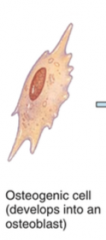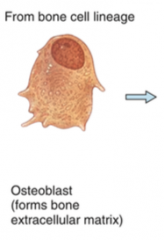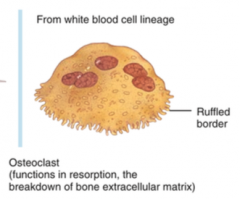![]()
![]()
![]()
Use LEFT and RIGHT arrow keys to navigate between flashcards;
Use UP and DOWN arrow keys to flip the card;
H to show hint;
A reads text to speech;
19 Cards in this Set
- Front
- Back
|
what are the 3 main materials bone is composed of |
support cells (osteoprogenitor cell, osteoblast, osteoclasts, osteocytes) non-mineral matrix of osteoid inorganic minerals stored within the matrix |
|
|
name the cavity in the middle of the diaphysis |
medullary cavity |
|
|
from "top to bottom" what are the main areas of the bone |
epiphysis epiphyseal line metaphysis diaphysis metaphysis epiphyseal line epiphysis |
|
|
what type of bone is found in the outer diaphysis
|
thick layer of cortical/compact bone
underneath which is a thin layer of spongy/trabecullar/cancellous bone |
|
|
what type of bone is found in the epiphysis |
spongy/cancellous/trabecular bone |
|
|
what is the outer layer of the bone called |
the periosteum |
|
|
what type of bone surrounds the medullary cavity of the diaphysis |
thick layer of compact bone
|
|
|
what feature of the epiphyseal growth plate in the metaphysis in growing bone allows |
layer of hyaline cartilage allowed diaphysis to grow in length |
|
|
what type of cartilage is in articular cartilage |
hyalin cartilage |
|
|
where is the articular cartilage found |
covers part of the epiphysis where the bone forms a joint with another bone |
|
|
what is the function of articular cartilage |
reduces friction and absorb shock |
|
|
why is damage to articular cartilage often irreversible |
because it lacks blood vessels and a perichondrium (the connective tissue that envelops cartilage where it is not at a joint) |
|
|
what is the inner and outer layer of the periosteum composed of |
inner osteogenic layer outer fibrous layer
|
|
|
what is the main function of the medullary cavity |
it is a hollow space and so it makes things lighter it contains yellow bone marrow |
|
|
what are osteogenic/osteoprogenitor cells |
unspecialised bone stem cells derived from mesenchyme (the tissue from which almost all connective tissues are formed) They are the only bone cells to undergo cell division, which develop into osteoblasts. |
|
|
where are osteogenic/osteoprogenitor cells found |

Osteogenic cells are found along the inner portion of the periosteum, in the endosteum and within bone that contain blood vessels. |
|
|
what are osteoblasts |

Osteoblasts are bone building cells. They synthesise and secrete collage fibres and other organic components needed to build the extracellular matrix of bone tissue, and they initiate calcification. As osteoblasts surround themselves with extracellular matrix, they become trapped in their secretions and become osteocytes. Ossification is the laying down of new bone material by osteoblasts. |
|
|
what are osteocytes |

Osteocytes are mature bone cells which maintain daily metabolism, such as the exchange of nutrients and wastes with the blood. They are the main cells in the bone tissue and they do not undergo any cell division. |
|
|
what are osteoclasts |

Osteoclasts are huge cells derived from the fusion of as many as 50 monocytes and are concentrated in the endosteum. On the side of the cell that faces the bone surface, the osteoclast’s plasma membrane is deeply folded into a ruffled border. Here the cell releases powerful lysosomal enzymes and acids that digest the protein and mineral components of the underlying extracellular bone matrix. This breakdown of bone extracellular matrix, termed resorption is part of the normal development, maintenance and repair of the bone. |

